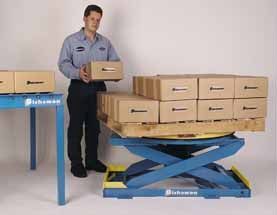Ergonomic Lift Tables: Save Your Workers' Backs
Are You Using Ergonomic Lift Tables Yet? If Not, Here’s Why You Should
The Cromer team has visited tens of thousands of our customers’ facilities over the years—warehouses, offices, docks, and manufacturers.
In our opinion, 80% of those facilities could benefit from investing in one piece of equipment—an ergonomic lift table.
If you’re not familiar with lift tables, this is the “News from the Forklift Boss” to read. We will cover what lift tables do, how best to use them in your facility, and some dos & don’ts to keep in mind.
What is an Ergonomic Lift Table?

An ergonomic lift table is a small mechanical or hydraulic scissor lift with a flat surface on top (pictured above). It provides a raised platform where you can stack boxes & pallets. Some models even have wheels.

Its purpose? To reduce workers’ fatigue, increase productivity, and foster a safer work environment. By lifting boxes or pallets up to a worker’s waist level, lift tables eliminate the need to bend over repeatedly while stacking product.
Lift tables come in three main types:
- Mechanical – uses a crank to lift
- Air Bag – uses factory air to lift
- Hydraulic – uses a hydraulic piston to lift
Lift Table Uses
The typical use of a lift table is in a warehouse. But we’ve also seen them used in mechanics’ garages, manufacturing plants, and even inside an industrial refrigerator. Lift tables are suitable for all types of environments (indoor and outdoor).
Lift tables speed up and simplify product movement. Lifting a group of boxes up to waist-height may not seem like much, but it can save a worker’s back.
Think of how many times a worker has to bend down, turn, lift, turn, set a box down, and repeat. One ergonomic lift table not only cuts down on all that motion, it can speed up pallet loading and unloading time by 40%.
Dos & Don’ts of Lift Tables
As with all material handling equipment, there’s a safe way to use lift tables and an unsafe way. Please follow these dos & don’ts to keep your workers safe.
- DO select the correct lift table for the product you’re moving. Make sure the capacity and height match the worker’s waist height.
- DO make use of a lift table wherever it improves worker health. Lift tables aren’t very expensive (starting at $2,000-$3,000), but they’re a huge money saver when you consider workers’ comp!
- DO locate and station the places in your warehouse where a lift table should go. These are places where floor-level stacking and sorting occurs most often.
- DON’T use a lift table in place of a pallet jack. It’s tempting to stack a mobile lift table, then push it where you want to go. Don’t do that—you risk spilling product off the table, onto you.
- DON’T exceed a lift table’s capacity. Each table has a capacity rating—beyond that, they can tip over.
- DON’T stand on a lift table. It’s not a ladder.
Choose the Right Lift Table, and Save Your Workers’ Backs!
The principle behind the ergonomic lift table is to reduce motion. The fewer times your workers have to bend down and pick up items, the fewer chances they have of injury.
Lift tables come in many sizes, types, and capacities. Choose the lift table best suited to your workers’ routines, and the types of product they are moving. You’ll get a great ROI from time saved, fewer workers’ comp claims, and healthier workers.
If you'd like to test out a lift table, call us! We have hydraulic lift tables for sale and rent (seasonal) in our Northern California locations.
Until next month!
Marshall Cromer, The Forklift Boss
Cromer Material Handling


